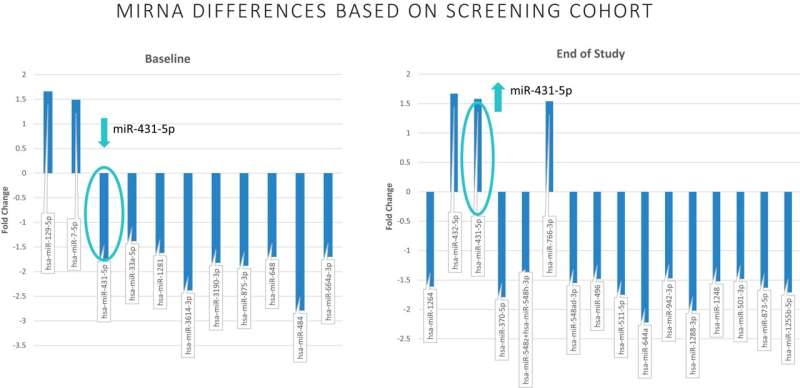This article has been reviewed according to Science X's editorial process and policies. Editors have highlighted the following attributes while ensuring the content's credibility:
fact-checked
peer-reviewed publication
trusted source
proofread
Circulating microRNAs likely as effective as A1C for predicting type 2 diabetes in youth, according to study

Type 2 diabetes in young people ages 10 to19 has more than doubled in the past 20 years, yet it remains difficult for physicians to predict who will be diagnosed and who will improve with treatment. A study from the University of Oklahoma shows that measuring the circulating abundance of microRNAs—which affect insulin-producing beta cells in the pancreas—is likely as effective as measuring the level of sugar in the blood for determining how a young person with the condition will fare.
The findings are published in The Journal of Clinical Endocrinology & Metabolism.
Jeanie Tryggestad, M.D., an associate professor of pediatrics in the OU College of Medicine, led the study. It marks one of the first times microRNA abundance has been explored to predict the progression of type 2 diabetes in youth. The specific microRNAs in the study are involved in insulin resistance and other actions that can stress beta cells or cause their death. The research is significant because it points to a process that is necessary to understand in order to ultimately design a strategy for prevention.
"Type 2 diabetes in youth is so aggressive, and the decline of beta cell function in youth is much more than we see in adults," Tryggestad said. "We believe that predicting what will cause beta cell dysfunction, and eventually preventing that dysfunction, is one of the keys for preventing or treating type 2 diabetes."
Tryggestad's study showed that the microRNAs, at baseline, were nearly as effective as A1C measurement (average level of blood sugar) when predicting who would fail to respond to treatment for type 2 diabetes. Treatment failure was defined as having an A1C of greater than 8% for six months or a circumstance that caused the study participant to go back on insulin without the ability to come back off. Circulating microRNAs also predicted a 20% decrease in beta cell function during the first six months of the study.
Currently, microRNAs can be measured only in a research setting, not in a clinic, but that may change in the future, Tryggestad said. The study's implications are important not only for the predictive potential of microRNAs, but because they represent a mechanism, or part of the process by which type 2 diabetes develops and worsens.
"Glucose and A1C are relevant to me as a clinician, but as a clinician-researcher, it's important to have this additional piece of information about microRNAs because it points us toward a mechanism. It's the mechanism that we need to understand to design a prevention. It adds a layer of understanding that we haven't had before," she said.
Addressing the dramatic increase in type 2 diabetes in children is only becoming more critical. Each year in the United States, cases of type 2 diabetes in youth increase by 5.3%. At that rate, the prevalence is expected to increase by a staggering 700% by the year 2060. Tryggestad said that today, more youth ages 15 to 19 are living with type 2 diabetes than type 1 diabetes—the first time that has ever happened.
The samples analyzed in this research came from participants in the landmark TODAY study (Treatment Options for type 2 Diabetes in Adolescents and Youth). The OU College of Medicine played a major role in the multi-center clinical trial, which began recruiting participants in 2003 and ended in 2020. The trial featured 699 study participants, and Oklahoma enrolled more patients than any other participating site.
The trial was the first and largest of its kind to compare treatments for type 2 diabetes in youth, but it has continued to yield information since the original study ended. The OU College of Medicine plans to analyze microRNA samples taken during the first 10 years of the study.
More information: Dakota Redling et al, Circulating MicroRNAs as Predictors of Beta Cell Function in Youth-onset Type 2 Diabetes: The TODAY Study, The Journal of Clinical Endocrinology & Metabolism (2024). DOI: 10.1210/clinem/dgae376





















